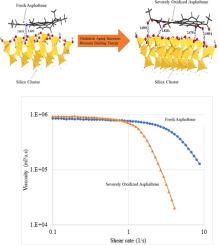Applied Surface Science ( IF 6.7 ) Pub Date : 2021-02-25 , DOI: 10.1016/j.apsusc.2021.149324 Amirul Islam Rajib , Saba Shariati , Elham H. Fini

|
Oxidative aging changes the composition of bitumen, and these changes affect the cohesive properties and adhesive properties of the bitumen. While cohesive properties of bitumen have been shown to be negatively impacted by aging, bitumen's bonding strength to stone aggregates can increase. Aging increases the concentration of asphaltenes and makes bitumen become more polar. It is hypothesized that oxidized asphaltenes show stronger interaction with siliceous substrates, promoting bitumen's bonding to siliceous stones. This study uses computational modeling and laboratory experiments to evaluate the interaction of progressively aged bitumen to siliceous substrates. To do so, asphalt samples aged from 20 to 60 h were prepared, and their bonding properties were examined in dry conditions and wet conditions. The study results showed that as bitumen becomes aged and/or exposed to water, its shear thinning increases. This result is supported by our modeling, which showed that both oxidation and trace water promote the formation of stable nanoaggregates of asphaltenes in bitumen, increasing bitumen's stiffness. In terms of bonding to stones, our modeling results showed that oxidized asphaltene and oxidized resin have higher interaction energies with siliceous surfaces than unoxidized versions. Our experiments found that glass beads had greater interaction with aged bitumen than with unaged bitumen. Furthermore, aged bitumen showed even higher interaction with glass when exposed to water compared to dry conditions, as shown by the moisture-induced shear-thinning index (MISTI) test. The latter observations indicate not only that water could not diffuse into the interface of aged bitumen and glass representing siliceous stone to weaken their bond, but also that water was driven away from the interface due to the strong bond of aged bitumen and siliceous stone, leading to trace water entering the bulk of bitumen. This in turn caused stable nanoaggregates, which in turn stiffened the bitumen. The study results provide insights into the role of oxidative aging in the bonding of bitumen to siliceous stone. The outcome of the study informs methods related to the extraction of oil from reservoir rocks as well as recycling agents for the removal of oxidized bitumen from siliceous stones in reclaimed asphalt pavements.
中文翻译:

渐进老化对沥青与硅石结合强度的影响
氧化老化改变了沥青的组成,并且这些变化影响了沥青的内聚性和粘合性。尽管已经显示出沥青的粘结性能会受到老化的负面影响,但沥青与石材聚集体的粘结强度却可以提高。老化会增加沥青质的浓度,并使沥青变得更极性。据推测,氧化的沥青质与硅质底物表现出更强的相互作用,从而促进了沥青与硅质石的键合。这项研究使用计算模型和实验室实验来评估逐渐老化的沥青与硅质基质的相互作用。为此,准备了20到60小时的沥青样品,并在干燥和潮湿条件下检查了它们的粘结性能。研究结果表明,随着沥青变老和/或暴露于水,其剪切稀化增加。该结果得到我们模型的支持,该模型表明氧化水和痕量水都促进沥青中沥青质稳定纳米聚集体的形成,从而增加了沥青的刚度。就结石而言,我们的建模结果表明,氧化的沥青质和氧化的树脂与硅质表面的相互作用能比未氧化的更高。我们的实验发现,玻璃珠与老化的沥青的相互作用要大于未老化的沥青。此外,与干燥条件相比,老化的沥青在暴露于水时与玻璃的相互作用更高,如水分诱导的剪切稀化指数(MISTI)测试所示。后一项观察结果表明,不仅水不能扩散到老化的沥青和代表硅质石的玻璃的界面中以削弱它们的结合力,而且还表明水由于老化的沥青和硅质石的牢固结合而被驱逐出界面,导致追踪进入大量沥青的水。反过来,这导致了稳定的纳米聚集体,反过来又使沥青变硬。研究结果为氧化老化在沥青与硅质石粘结中的作用提供了见识。这项研究的结果为从储层岩石中提取油以及用于从再生沥青路面的硅质石中去除氧化沥青的回收剂提供了信息。



























 京公网安备 11010802027423号
京公网安备 11010802027423号